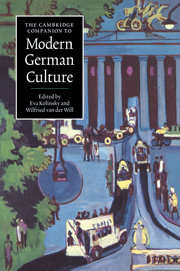Book contents
- Frontmatter
- In search of German culture: an introduction
- 1 The citizen and the state in modern Germany
- 2 German national identity
- 3 Elites and class structure
- 4 Jews in German society
- 5 Non-German minorities, women and the emergence of civil society
- 6 Critiques of culture
- 7 The functions of 'Volkskultur', mass culture and alternative culture
- 8 The development of German prose fiction
- 9 Modern German poetry
- 10 German drama, theatre and dance
- 11 Music in modern German culture
- 12 Modern German art
- 13 Modern German architecture
- 14 German cinema
- 15 The media of mass communication: the press, radio and television
- Index
3 - Elites and class structure
Published online by Cambridge University Press: 28 May 2006
- Frontmatter
- In search of German culture: an introduction
- 1 The citizen and the state in modern Germany
- 2 German national identity
- 3 Elites and class structure
- 4 Jews in German society
- 5 Non-German minorities, women and the emergence of civil society
- 6 Critiques of culture
- 7 The functions of 'Volkskultur', mass culture and alternative culture
- 8 The development of German prose fiction
- 9 Modern German poetry
- 10 German drama, theatre and dance
- 11 Music in modern German culture
- 12 Modern German art
- 13 Modern German architecture
- 14 German cinema
- 15 The media of mass communication: the press, radio and television
- Index
Summary
In the roughly 150 years between the middle of the eighteenth century and re-unification, German society faced two major economic and socio-structural revolutions. The industrial revolution, which lasted from the early 1840s to the eve of the First World War, turned a still predominantly feudal society into a largely industrial society. The second revolution, which one might call a material revolution, transformed post-war German society between 1950 and 1970 from a society deeply scarred by dictatorship, defeat, and destruction into one of the most affluent societies in Western Europe. Despite the structural similarities of the two revolutions, their outcomes were radically different. The industrial revolution ended in totalitarian dictatorship and the most destructive war in European history; from the second revolution, the vast majority of the divided nation emerged as a stable and increasingly pluralist democracy.
Historians and social scientists have proposed a number of interpretations to explain how a combination of various 'peculiarities of German history' in the nineteenth century led to the catastrophes of the first half of the twentieth century. Although the notion of a German Sonderweg (idiosyncratic development) has been significantly modified and to some extent discredited, it still retains some validity with respect to at least one problem: namely, that in Germany in the nineteenth century, the transformation of the social and political structure failed to keep pace with the progress of industrialisation. In Germany, unlike other industrialised countries, pre-industrial elites retained their predominant social and political position against the newly emerging industrial classes, stifling societal modernisation and inhibiting the evolution of a democratic political culture.
- Type
- Chapter
- Information
- The Cambridge Companion to Modern German Culture , pp. 67 - 85Publisher: Cambridge University PressPrint publication year: 1999



